Advancements in Flexible Nanogenerators: Polyvinylidene Fluoride-Based Nanofiber Utilizing Electrospinning
Abstract
:1. Introduction
2. Fabrication of PVDF-Based Nanofibrous Mesh by Electrospinning
2.1. PVDF
2.2. Co-Polymer
3. Applications of PVDF Mesh to Nanogenerator
3.1. Piezoelectric Nanogenerator (PENG)
3.2. Triboelectric Nanogenerator (TENG)
3.3. Hybrid Nanogenerator (HNG)
4. Enhancement Techniques of Harvesting Output
4.1. Aligning Fiber Structure
4.2. Doping Additives
4.3. Coaxial Electrospinning
4.4. Electroless Plating
4.5. Modifying Structure of Device
4.6. Other Methods
5. Further Application to Various Sensors
5.1. Tactile and Human Motion Sensor
5.2. Respiratory Monitoring
5.3. Sound Sensor
5.4. Displacement Sensor
6. Conclusions
Author Contributions
Funding
Institutional Review Board Statement
Informed Consent Statement
Data Availability Statement
Acknowledgments
Conflicts of Interest
References
- Arica, T.A.; Isık, T.; Guner, T.; Horzum, N.; Demir, M.M. Advances in Electrospun Fiber-Based Flexible Nanogenerators for Wearable Applications. Macromol. Mater. Eng. 2021, 306, 2100143. [Google Scholar] [CrossRef]
- Zhu, J.; Zhu, M.; Shi, Q.; Wen, F.; Liu, L.; Dong, B.; Haroun, A.; Yang, Y.; Vachon, P.; Guo, X.; et al. Progress in TENG technology—A journey from energy harvesting to nanoenergy and nanosystem. Ecomat 2020, 2, e12058. [Google Scholar] [CrossRef]
- Kim, W.G.; Kim, D.W.; Tcho, I.W.; Kim, J.K.; Kim, M.S.; Choi, Y.K. Triboelectric Nanogenerator: Structure, Mechanism, and Applications. ACS Nano 2021, 15, 258. [Google Scholar] [CrossRef] [PubMed]
- Hao, D.; Qi, L.; Tairab, A.M.; Ahmed, A.; Azam, A.; Luo, D.; Pan, Y.; Zhang, Z.; Yan, J. Solar energy harvesting technologies for PV self-powered applications: A comprehensive review. Renew. Energy 2022, 188, 678. [Google Scholar] [CrossRef]
- Wang, J.; Geng, L.; Ding, L.; Zhu, H.; Yurchenko, D. The state-of-the-art review on energy harvesting from flow-induced vibrations. Appl. Energy 2020, 267, 114902. [Google Scholar] [CrossRef]
- Nesrine, J.; Ayda, B.; Jens, M.; Brahim, M.; Fares, T.; Mohammed, I. A comprehensive review of Thermoelectric Generators: Technologies and common applications. Energy Rep. 2020, 6, 264–287. [Google Scholar]
- Sezer, N.; Koç, M. A comprehensive review on the state-of-the-art of piezoelectric energy harvesting. Nano Energy 2021, 80, 105567. [Google Scholar] [CrossRef]
- Pu, X.; Wang, Z.L. Self-charging power system for distributed energy: Beyond the energy storage unit. Chem. Sci. 2020, 12, 34. [Google Scholar] [CrossRef]
- Xu, Q.; Wen, J.; Qin, Y. Development and outlook of high output piezoelectric nanogenerators. Nano Energy 2021, 86, 106080. [Google Scholar] [CrossRef]
- Hongmei, Y.; Feng Ru, F.; Yi, X.; Wenzhuo, W. Design and engineering of high-performance triboelectric nanogenerator for ubiquitous unattended devices. EcoMat 2021, 3, e12093. [Google Scholar]
- Cao, C.; Li, Z.; Shen, F.; Zhang, Q.; Gong, Y.; Guo, H.; Peng, Y.; Wang, Z.L. Progress on techniques for improving output performance of triboelectric nanogenerators. Energy Environ. Sci. 2023, 17, 885–924. [Google Scholar] [CrossRef]
- Abbasipour, M.; Khajavi, R.; Yousefi, A.A.; Yazdanshenas, M.E.; Razaghian, F.; Akbarzadeh, A. Improving piezoelectric and pyroelectric properties of electrospun PVDF nanofibers using nanofillers for energy harvesting application. Polym. Adv. Technol. 2019, 30, 279–291. [Google Scholar] [CrossRef]
- Gui, J.; Zhu, Y.; Zhang, L.; Shu, X.; Liu, W.; Guo, S.; Zhao, X. Enhanced output-performance of piezoelectric poly(vinylidene fluoride trifluoroethylene) fibers-based nanogenerator with interdigital electrodes and well-ordered cylindrical cavities. Appl. Phys. Lett. 2018, 112, 1. [Google Scholar] [CrossRef]
- Mishra, S.; Unnikrishnan, L.; Nayak, S.K.; Mohanty, S. Advances in Piezoelectric Polymer Composites for Energy Harvesting Applications: A Systematic Review. Macromol. Mater. Eng. 2019, 304, 1800463–1800487. [Google Scholar] [CrossRef]
- Cao, X.; Xiong, Y.; Sun, J.; Zhu, X.; Sun, Q.; Wang, Z.L. Piezoelectric Nanogenerators Derived Self-Powered Sensors for Multifunctional Applications and Artificial Intelligence. Adv. Funct. Mater. 2021, 31, 2102983. [Google Scholar] [CrossRef]
- Habib, M.; Lantgios, I.; Hornbostel, K. A review of ceramic, polymer and composite piezoelectric materials. J. Phys. D Appl. Phys. 2022, 55, 423002. [Google Scholar] [CrossRef]
- Wang, X.; Yin, G.; Liu, B.; Sun, F.; Wang, Y.; Dong, M. Tactile-sensing based on flexible PVDF nanofibers via electrospinning: A review. Sensors 2018, 18, 330. [Google Scholar] [CrossRef] [PubMed]
- Ramadan, K.S.; Sameoto, D.; Evoy, S. A review of piezoelectric polymers as functional materials for electromechanical transducers. Smart Mater. Struct. 2014, 23, 33001–33026. [Google Scholar] [CrossRef]
- Ruan, L.; Yao, X.; Chang, Y.; Zhou, L.; Qin, G.; Zhang, X. Properties and Applications of the β Phase Poly(vinylidene fluoride). Polymers 2018, 10, 228. [Google Scholar] [CrossRef]
- Smith, M.; Kar-Narayan, S. Piezoelectric polymers: Theory, challenges and opportunities. Int. Mater. Rev. 2022, 67, 65–88. [Google Scholar] [CrossRef]
- Tan, H.; Si, W.; Peng, W.; Chen, X.; Liu, X.; You, Y.; Wang, L.; Hou, F.; Liang, J. Flexo-/piezoelectric polarization boosting exciton dissociation in curved two-dimensional carbon nitride photocatalyst. Nano Letters. 2023, 23, 10571. [Google Scholar] [CrossRef] [PubMed]
- Ferrie, S.; Darwish, N.; Gooding, J.J.; Ciampi, S. Harnessing silicon facet-dependent conductivity to enhance the direct-current produced by a sliding Schottky diode triboelectric nanogenerator. Nano Energy 2020, 78, 105210. [Google Scholar] [CrossRef]
- Khalifa, M.; Lammer, H.; Gupta, N.; Bagawan, A.H.; Wuzella, G. Multifunctional PVDF film embedded with surfactant assisted-graphene with excellent piezo-capacitance, piezoelectric and triboelectric properties for various applications. Polymer 2023, 286, 126383. [Google Scholar] [CrossRef]
- Zhang, J.; Rogers, F.J.; Darwish, N.; Gonçales, V.R.; Vogel, Y.B.; Wang, F.; Gooding, J.J.; Peiris, M.C.R.; Jia, G.; Veder, J.-P. Electrochemistry on tribocharged polymers is governed by the stability of surface charges rather than charging magnitude. J. Am. Chem. Soc. 2019, 141, 5863. [Google Scholar] [CrossRef] [PubMed]
- Liu, C.; Xu, H.; Huo, B.; Wang, J.; Wang, Z.; Chen, X.; Meng, F.; Sun, C.; Wang, Y. Research progress of PVDF based piezoelectric polymer composites in water pollution remediation. J. Water Process Eng. 2023, 55, 104181. [Google Scholar] [CrossRef]
- Ico, G.; Myung, A.; Kim, B.S.; Myung, N.V.; Nam, J. Transformative piezoelectric enhancement of P(VDF-TrFE) synergistically driven by nanoscale dimensional reduction and thermal treatment. Nanoscale 2018, 10, 2894–2901. [Google Scholar] [CrossRef] [PubMed]
- Salimi, A.; Yousefi, A.A. Analysis Method: FTIR studies of β-phase crystal formation in stretched PVDF films. Polym. Test. 2003, 22, 699–704. [Google Scholar] [CrossRef]
- Wan, C.; Bowen, C.R. Multiscale-structuring of polyvinylidene fluoride for energy harvesting: The impact of molecular-, micro- and macro-structure. J. Mater. Chem. A 2017, 5, 3091–3128. [Google Scholar] [CrossRef]
- Banerjee, S.; Bairagi, S.; Ali, S.W. A critical review on lead-free hybrid materials for next generation piezoelectric energy harvesting and conversion. Ceram. Int. 2021, 47, 16402–16421. [Google Scholar] [CrossRef]
- Feng, Z.; Zhao, Z.; Liu, Y.; Liu, Y.; Cao, X.; Yu, D.G.; Wang, K. Piezoelectric effect polyvinylidene fluoride (PVDF): From energy harvester to smart skin and electronic textiles. Adv. Mater. Technol. 2023, 8, 2300021. [Google Scholar] [CrossRef]
- Li, L.; Xu, J.; Liu, J.; Gao, F. Recent progress on piezoelectric energy harvesting: Structures and materials. Adv. Compos. Hybrid Mater. 2018, 1, 478–505. [Google Scholar] [CrossRef]
- Ameduri, B. From vinylidene fluoride (VDF) to the applications of VDF-containing polymers and copolymers: Recent developments and future trends. Chem. Rev. 2009, 109, 6632. [Google Scholar] [CrossRef] [PubMed]
- Cai, Y.; Gevelber, M. Analysis of bending region physics in determining electrospun fiber diameter: Effect of relative humidity on evaporation and force balance. J. Mater. Sci. 2017, 52, 2605–2627. [Google Scholar] [CrossRef]
- Angammana, C.J.; Jayaram, S.H. Fundamentals of electrospinning and processing technologies. Part. Sci. Technol. 2016, 34, 72–82. [Google Scholar] [CrossRef]
- Liu, Y.-Z.; Zhang, Q.; Wang, X.-X.; Lu, Y.; Li, W.-B.; Peng, Q.-Y.; Xu, F.-Y. Review of Electrospinning in the Fabrication of Nanogenerators. ACS Appl. Nano Mater. 2024, 7, 4630. [Google Scholar] [CrossRef]
- Gulnur, K.; Nursultan, T.; Ingkar, A.; Alisher, M.; Arailym, N.; Desmond, A.; Zhumabay, B. A Review of Piezoelectric PVDF Film by Electrospinning and Its Applications. Sensors 2020, 20, 5214. [Google Scholar] [CrossRef] [PubMed]
- Yu, Y.J.; McGaughey, A.J. Energy barriers for dipole moment flipping in PVDF-related ferroelectric polymers. J. Chem. Phys. 2016, 144, 014901. [Google Scholar] [CrossRef] [PubMed]
- Lei, T.; Yu, L.; Zheng, G.; Wang, L.; Wu, D.; Sun, D. Electrospinning-induced preferred dipole orientation in PVDF fibers. J. Mater. Sci. 2015, 50, 4342–4347. [Google Scholar] [CrossRef]
- Chang, J.; Dommer, M.; Chang, C.; Lin, L. Piezoelectric nanofibers for energy scavenging applications. Nano Energy 2012, 1, 356. [Google Scholar] [CrossRef]
- Li, T.; Feng, Z.Q.; Yan, K.; Yuan, T.; Wei, W.; Yuan, X.; Wang, C.; Wang, T.; Dong, W.; Zheng, J. Pure OPM nanofibers with high piezoelectricity designed for energy harvesting in vitro and in vivo. J. Mater. Chem. B 2018, 6, 5343. [Google Scholar] [CrossRef]
- Yonggang, J.; Longlong, G.; Xiaohe, H.; Yong, Z.; Huawei, C.; Lin, F.; Deyuan, Z. Aligned P(VDF-TrFE) Nanofibers for Enhanced Piezoelectric Directional Strain Sensing. Polymers 2018, 10, 364. [Google Scholar] [CrossRef] [PubMed]
- Jiang, S.; Chen, Y.; Duan, G.; Mei, C.; Greiner, A.; Agarwal, S. Electrospun nanofiber reinforced composites: A review. Polym. Chem. 2018, 9, 2685–2720. [Google Scholar] [CrossRef]
- Lin, M.-F.; Xiong, J.; Wang, J.; Parida, K.; Lee, P.S. Core-shell nanofiber mats for tactile pressure sensor and nanogenerator applications. Nano Energy 2018, 44, 248–255. [Google Scholar] [CrossRef]
- Chen, F.; Wu, Y.; Ding, Z.; Li, S.; Zheng, H.; Diao, C.; Yue, G.; Xia, X.; Zi, Y. A novel triboelectric nanogenerator based on electrospun polyvinylidene fluoride nanofibers for effective acoustic energy harvesting and self-powered multifunctional sensing. Nano Energy 2019, 56, 241. [Google Scholar] [CrossRef]
- Liu, Z.; Zhang, S.; Jin, Y.M.; Ouyang, H.; Zou, Y.; Wang, X.X.; Xie, L.X.; Li, Z. Flexible piezoelectric nanogenerator in wearable self-powered active sensor for respiration and healthcare monitoring. Semicond. Sci. Technol. 2017, 32, 064004. [Google Scholar] [CrossRef]
- Zhao, J.; Li, F.; Wang, Z.; Dong, P.; Xia, G.; Wang, K. Flexible PVDF nanogenerator-driven motion sensors for human body motion energy tracking and monitoring. J. Mater. Sci.-Mater. Electron. 2021, 32, 14715–14727. [Google Scholar] [CrossRef]
- Zaarour, B.; Zhang, W.; Zhu, L.; Jin, X.Y.; Huang, C. Maneuvering surface structures of polyvinylidene fluoride nanofibers by controlling solvent systems and polymer concentration. Text. Res. J. 2019, 89, 2406. [Google Scholar] [CrossRef]
- Chinaglia, D.L.; Gregorio, R., Jr.; Stefanello, J.C.; Pisani Altafim, R.A.; Wirges, W.; Wang, F.; Gerhard, R. Influence of the Solvent Evaporation Rate on the Crystalline Phases of Solution-Cast Poly(Vinylidene Fluoride) Films. J. Appl. Polym. Sci. 2010, 116, 785–791. [Google Scholar] [CrossRef]
- Greiner, A.; Wendorff, J.H. Electrospinning: A fascinating method for the preparation of ultrathin fibers. Angew. Chem. 2007, 46, 5670. [Google Scholar] [CrossRef]
- Bilal, Z.; Lei, Z.; Xiangyu, J. Maneuvering the secondary surface morphology of electrospun poly (vinylidene fluoride) nanofibers by controlling the processing parameters. Mater. Res. Express 2019, 7, 015008. [Google Scholar]
- Behroozi, A.H.; Al-Shaeli, M.; Vatanpour, V. Fabrication and modification of nanofiltration membranes by solution electrospinning technique: A review of influential factors and applications in water treatment. Desalination 2023, 558, 116638. [Google Scholar] [CrossRef]
- Kianfar, P.; Bongiovanni, R.; Ameduri, B.; Vitale, A. Electrospinning of Fluorinated Polymers: Current State of the Art on Processes and Applications. Polym. Rev. 2023, 63, 127–199. [Google Scholar] [CrossRef]
- Zheng, J.; He, A.; Li, J.; Han, C.C. Polymorphism control of poly(vinylidene fluoride) through electrospinning. Macromol. Rapid Commun. 2007, 28, 2159–2162. [Google Scholar] [CrossRef]
- Zaarour, B.; Zhu, L.; Huang, C.; Jin, X. Fabrication of a polyvinylidene fluoride cactus-like nanofiber through one-step electrospinning. RSC Adv. 2018, 8, 42353. [Google Scholar] [CrossRef]
- Hu, P.; Zheng, D.; Zhao, C.; Zhang, Y.; Niu, J. Linear dependence between content of effective piezo-phase and mechanical-to-electrical conversion in electrospun poly(vinylidene fluoride) fibrous membrane. Mater. Lett. 2018, 218, 71–75. [Google Scholar] [CrossRef]
- Kang, S.B.; Won, S.H.; Im, M.J.; Kim, C.U.; Park, W.I.; Baik, J.M.; Choi, K.J. Enhanced piezoresponse of highly aligned electrospun poly(vinylidene fluoride) nanofibers. Nanotechnology 2017, 28, 395402. [Google Scholar] [CrossRef]
- Ribeiro, C.; Sencadas, V.; Gomez Ribelles, J.L.; Lanceros-Mendez, S. Influence of Processing Conditions on Polymorphism and Nanofiber Morphology of Electroactive Poly(vinylidene fluoride) Electrospun Membranes. Soft Mater. 2010, 8, 274–287. [Google Scholar] [CrossRef]
- Gao, K.; Hu, X.; Dai, C.; Yi, T. Crystal structures of electrospun PVDF membranes and its separator application for rechargeable lithium metal cells. Mater. Sci. Eng. B-Solid State Mater. Adv. Technol. 2006, 131, 100–105. [Google Scholar] [CrossRef]
- Gee, S.; Johnson, B.; Smith, A.L. Optimizing electrospinning parameters for piezoelectric PVDF nanofiber membranes. J. Membr. Sci. 2018, 563, 804–812. [Google Scholar] [CrossRef]
- Bae, J.; Baek, I.; Choi, H. Efficacy of piezoelectric electrospun nanofiber membrane for water treatment. Chem. Eng. J. 2017, 307, 670. [Google Scholar] [CrossRef]
- Luo, C.J.; Nangrejo, M.; Edirisinghe, M. A novel method of selecting solvents for polymer electrospinning. Polymer 2010, 51, 1654–1662. [Google Scholar] [CrossRef]
- Lins, L.C.; Wianny, F.; Livi, S.; Dehay, C.; Duchet-Rumeau, J.; Gérard, J.F. Effect of polyvinylidene fluoride electrospun fiber orientation on neural stem cell differentiation. J. Biomed. Mater. Res. Part B Appl. Biomater. 2017, 105, 2376. [Google Scholar] [CrossRef] [PubMed]
- Mirjalali, S.; Mahdavi Varposhti, A.; Abrishami, S.; Bagherzadeh, R.; Asadnia, M.; Huang, S.; Peng, S.; Wang, C.H.; Wu, S. A review on wearable electrospun polymeric piezoelectric sensors and energy harvesters. Macromol. Mater. Eng. 2023, 308, 2200442. [Google Scholar] [CrossRef]
- Yu, L.; Cebe, P. Crystal polymorphism in electrospun composite nanofibers of poly(vinylidene fluoride) with nanoclay. Polymer 2009, 50, 2133. [Google Scholar] [CrossRef]
- Benz, M.; Euler, W.B. Determination of the crystalline phases of poly(vinylidene fluoride) under different preparation conditions using differential scanning calorimetry and infrared spectroscopy. J. Appl. Polym. Sci. 2003, 89, 1093–1100. [Google Scholar] [CrossRef]
- Liang, Y.; Cheng, S.; Zhao, J.; Zhang, C.; Sun, S.; Zhou, N.; Qiu, Y.; Zhang, X. Heat treatment of electrospun Polyvinylidene fluoride fibrous membrane separators for rechargeable lithium-ion batteries. J. Power Sources 2013, 240, 204–211. [Google Scholar] [CrossRef]
- Choi, S.S.; Lee, Y.S.; Joo, C.W.; Lee, S.G.; Park, J.K.; Han, K.S. Electrospun PVDF nanofiber web as polymer electrolyte or separator. Electrochim. Acta 2004, 50, 339–343. [Google Scholar] [CrossRef]
- Soulestin, T.; Ladmiral, V.; Dos Santos, F.D.; Ameduri, B. Vinylidene fluoride- and trifluoroethylene-containing fluorinated electroactive copolymers. How does chemistry impact properties? Prog. Polym. Sci. 2017, 72, 16–60. [Google Scholar] [CrossRef]
- Jia, N.; He, Q.; Song, R.; Sun, J.; Xia, G. Crystallization behavior and electroactive properties of PVDF, P(VDF-TrFE) and their blend films. Polym. Test. 2017, 57, 302. [Google Scholar] [CrossRef]
- Li, Z.; Liao, J.; Xi, Z.; Zhu, W.; Zhang, Z. Influence of Steric Hindrance on Ferro- and Piezoelectric Performance of Poly(vinylidene fluoride)-Based Ferroelectric Polymers. Macromol. Chem. Phys. 2019, 220, 1900273. [Google Scholar] [CrossRef]
- Wang, X.; Qiao, B.; Tan, S.; Zhu, W.; Zhang, Z. Tuning the ferroelectric phase transition of PVDF by uniaxially stretching crosslinked PVDF films with CF-CH bonds. J. Mater. Chem. C 2020, 8, 11426–11440. [Google Scholar] [CrossRef]
- Abolhasani, M.M.; Shirvanimoghaddam, K.; Khayyam, H.; Moosavi, S.M.; Zohdi, N.; Naebe, M. Towards predicting the piezoelectricity and physiochemical properties of the electrospun P(VDF-TrFE) nanogenrators using an artificial neural network. Polym. Test. 2018, 66, 178–188. [Google Scholar] [CrossRef]
- Aochen, W.; Ming, H.; Liwei, Z.; Xiaoyong, Q. Self-Powered Well-Aligned P(VDF-TrFE) Piezoelectric Nanofiber Nanogenerator for Modulating an Exact Electrical Stimulation and Enhancing the Proliferation of Preosteoblasts. Nanomaterials 2019, 9, 349. [Google Scholar] [CrossRef] [PubMed]
- Wu, L.; Hu, N.; Li, W.; Tang, S.; Ying, J.; Chen, Z.; Huang, G.; Fu, S.; Qiu, J.; Wang, Z. Improvement of the piezoelectric properties of PVDF-HFP using AgNWs. RSC Adv. 2014, 4, 35896. [Google Scholar] [CrossRef]
- Bouhamed, A.; Binyu, Q.; Boehm, B.; Joehrmann, N.; Behme, N.; Goedel, W.A.; Wunderle, B.; Hellwig, O.; Kanoun, O. A hybrid piezoelectric composite flexible film based on PVDF-HFP for boosting power generation. Compos. Sci. Technol. 2021, 208, 108769–108779. [Google Scholar] [CrossRef]
- Xin, Y.; Zhu, J.; Sun, H.; Xu, Y.; Liu, T.; Qian, C. A brief review on piezoelectric PVDF nanofibers prepared by electrospinning. Ferroelectrics 2018, 526, 140. [Google Scholar] [CrossRef]
- Li, Y.; Luo, Y.; Deng, H.; Shi, S.; Tian, S.; Wu, H.; Tang, J.; Zhang, C.; Zhang, X.; Zha, J.W. Advanced Dielectric Materials for Triboelectric Nanogenerators: Principles, Methods, and Applications. Adv. Mater. 2024, 2314380. [Google Scholar] [CrossRef]
- Xue, L.; Fan, W.; Yu, Y.; Dong, K.; Liu, C.; Sun, Y.; Zhang, C.; Chen, W.; Lei, R.; Rong, K.; et al. A Novel Strategy to Fabricate Core-Sheath Structure Piezoelectric Yarns for Wearable Energy Harvesters. Adv. Fiber Mater. 2021, 3, 239–250. [Google Scholar] [CrossRef]
- Ge, X.; Hu, N.; Yan, F.; Wang, Y. Development and applications of electrospun nanofiber-based triboelectric nanogenerators. Nano Energy 2023, 112, 108444. [Google Scholar] [CrossRef]
- Zhang, R.; Olin, H. Material choices for triboelectric nanogenerators: A critical review. EcoMat 2020, 2, e12062. [Google Scholar] [CrossRef]
- Chansaengsri, K.; Onlaor, K.; Tunhoo, B.; Thiwawong, T. Paper-based flexible piezoelectric nanogenerator using fibrous polymer/piezoelectric nanoparticle composite material. Electron. Lett. 2018, 54, 772–773. [Google Scholar] [CrossRef]
- Zaarour, B.; Zhu, L.; Huang, C.; Jin, X. Enhanced piezoelectric properties of randomly oriented and aligned electrospun PVDF fibers by regulating the surface morphology. J. Appl. Polym. Sci. 2019, 136, 47049–47056. [Google Scholar] [CrossRef]
- Khalifa, M.; Mahendran, A.; Anandhan, S. Synergism of graphitic-carbon nitride and electrospinning on the physico-chemical characteristics and piezoelectric properties of flexible poly(vinylidene fluoride) based nanogenerator. J. Polym. Res. 2019, 26, 73–85. [Google Scholar] [CrossRef]
- Mansouri, S.; Sheikholeslami, T.F.; Behzadmehr, A. Investigation on the electrospun PVDF/NP-ZnO nanofibers for application in environmental energy harvesting. J. Mater. Res. Technol.-JmrT 2019, 8, 1608–1615. [Google Scholar] [CrossRef]
- Alam, M.M.; Ghosh, S.K.; Sultana, A.; Mandal, D. An Effective Wind Energy Harvester of Paper Ash-Mediated Rapidly Synthesized ZnO Nanoparticle-Interfaced Electrospun PVDF Fiber. Acs Sustain. Chem. Eng. 2018, 6, 292–299. [Google Scholar] [CrossRef]
- Alam, M.M.; Sultana, A.; Mandal, D. Biomechanical and Acoustic Energy Harvesting from TiO2 Nanoparticle Modulated PVDF Nanofiber Made High Performance Nanogenerator. ACS Appl. Energy Mater. 2018, 1, 3103. [Google Scholar] [CrossRef]
- He, Z.; Gao, B.; Li, T.; Liao, J.; Liu, B.; Liu, X.; Wang, C.; Feng, Z.; Gu, Z. Piezoelectric-Driven Self-Powered Patterned Electrochromic Supercapacitor for Human Motion Energy Harvesting. Acs Sustain. Chem. Eng. 2019, 7, 1745–1759. [Google Scholar] [CrossRef]
- Sun, B.; Li, X.; Zhao, R.; Ji, H.; Qiu, J.; Zhang, N.; He, D.; Wang, C. Electrospun poly(vinylidene fluoride)-zinc oxide hierarchical composite fiber membrane as piezoelectric acoustoelectric nanogenerator. J. Mater. Sci. 2019, 54, 2754–2762. [Google Scholar] [CrossRef]
- Yu, H.; Yu, B.; Huang, T.; Wang, C.; Wang, H.; Zhu, M. Preparation and optimization of Polyvinylidene fluoride (PVDF) triboelectric nanogenerator via electrospinning. In Proceedings of the 2015 IEEE 15th International Conference on Nanotechnology (IEEE-NANO), Nanotechnology (IEEE-NANO), 2015 IEEE 15th International Conference on 2015, Rome, Italy, 27–30 July 2015; pp. 1485–1488. [Google Scholar]
- Yu, H.; Zhu, M.; Yu, B.; Huang, T.; Wang, H. A biomimetic nanofiber-based triboelectric nanogenerator with an ultrahigh transfer charge density. Nano Energy 2018, 48, 464. [Google Scholar] [CrossRef]
- Garcia, C.; Trendafilova, I.; Guzman de Villoria, R.; Sanchez del Rio, J. Self-powered pressure sensor based on the triboelectric effect and its analysis using dynamic mechanical analysis. Nano Energy 2018, 50, 401–409. [Google Scholar] [CrossRef]
- Qin, Z.; Yin, Y.; Zhang, W.; Li, C.; Pan, K. Wearable and Stretchable Triboelectric Nanogenerator Based on Crumpled Nanofibrous Membranes. ACS Appl. Mater. Interfaces 2019, 11, 12452. [Google Scholar] [CrossRef] [PubMed]
- Kim, S.R.; Yoo, J.H.; Park, J.W. Using Electrospun AgNW/P(VDF-TrFE) Composite Nanofibers to Create Transparent and Wearable Single-Electrode Triboelectric Nanogenerators for Self-Powered Touch Panels. ACS Appl. Mater. Interfaces 2019, 11, 15088. [Google Scholar] [CrossRef] [PubMed]
- Ren, X.; Fan, H.; Wang, C.; Ma, J.; Li, H.; Zhang, M.; Lei, S.; Wang, W. Wind energy harvester based on coaxial rotatory freestanding triboelectric nanogenerators for self-powered water splitting. Nano Energy 2018, 50, 562. [Google Scholar] [CrossRef]
- Hansen, B.J.; Liu, Y.; Yang, R.; Wang, Z.L. Hybrid nanogenerator for concurrently harvesting biomechanical and biochemical energy. ACS Nano 2010, 4, 3647. [Google Scholar] [CrossRef] [PubMed]
- Fuh, Y.K.; Li, S.C.; Chen, C.Y.; Tsai, C.Y. A fully packaged self-powered sensor based on near-field electrospun arrays of poly(vinylidene fluoride) nano/micro fibers. Express Polym. Lett. 2018, 12, 136–145. [Google Scholar] [CrossRef]
- Guo, Y.; Zhang, X.-S.; Wang, Y.; Gong, W.; Zhang, Q.; Wang, H.; Brugger, J. All-fiber hybrid piezoelectric-enhanced triboelectric nanogenerator for wearable gesture monitoring. Nano Energy 2018, 48, 152–160. [Google Scholar] [CrossRef]
- Sahatiya, P.; Kannan, S.; Badhulika, S. Few layer MoS2 and in situ poled PVDF nanofibers on low cost paper substrate as high performance piezo-triboelectric hybrid nanogenerator: Energy harvesting from handwriting and human touch. Appl. Mater. Today 2018, 13, 91–99. [Google Scholar] [CrossRef]
- Xiangxin, D.; Zheng, Z.; Zhao, Z.; Liqin, Y.; Qilong, Z.; Hui, Y. Porous, multi-layered piezoelectric composites based on highly oriented PZT/PVDF electrospinning fibers for high-performance piezoelectric nanogenerators. J. Adv. Ceram. 2022, 11, 331–344. [Google Scholar]
- Sujian, Y.; Lingling, Z.; Jinzheng, G.; Heng, C.; Shishang, G. A Flexible Piezoelectric Nanogenerator Based on Aligned P(VDF-TrFE) Nanofibers. Micromachines 2019, 10, 302. [Google Scholar] [CrossRef]
- Pascariu, P.; Tudose, I.V.; Pachiu, C.; Danila, M.; Ioncscu, O.; Popescu, M.; Koudoumas, E.; Suchea, M. Graphene and TiO2- PVDF Nanocomposites for Potential Applications in Triboelectronics. In Proceedings of the 2018 International Semiconductor Conference (CAS), International Semiconductor Conference (CAS), Sinaia, Romania, 10–12 October 2018; pp. 237–240. [Google Scholar]
- Parangusan, H.; Ponnamma, D.; Al-Maadeed, M.A.A. Stretchable Electrospun PVDF-HFP/Co-ZnO Nanofibers as Piezoelectric Nanogenerators. Sci. Rep. 2018, 8, 754. [Google Scholar] [CrossRef]
- Kim, H.-S.; Park, I.-K. Enhanced output power from triboelectric nanogenerators based on electrospun Eu-doped polyvinylidene fluoride nanofibers. J. Phys. Chem. Solids 2018, 117, 188–193. [Google Scholar] [CrossRef]
- Khalifa, M.; Deeksha, B.; Anandhan, S.; Mahendran, A. Synergism of Electrospinning and Nano-alumina Trihydrate on the Polymorphism, Crystallinity and Piezoelectric Performance of PVDF Nanofibers. JOM 2018, 70, 1313. [Google Scholar] [CrossRef]
- Sultana, A.; Alam, M.M.; Sadhukhan, P.; Ghorai, U.K.; Das, S.; Middya, T.R.; Mandal, D. Organo-lead halide perovskite regulated green light emitting poly(vinylidene fluoride) electrospun nanofiber mat and its potential utility for ambient mechanical energy harvesting application. Nano Energy 2018, 49, 380–392. [Google Scholar] [CrossRef]
- Zhou, S.; Zhang, H.; Du, C.; Liu, M.; Liu, L.; Zhang, Y. Chitosan-Doped PVDF Film with Enhanced Electroactive β Phase for Piezoelectric Sensing. ACS Appl. Electron. Mater. 2024, 6, 2575. [Google Scholar] [CrossRef]
- Ghosh, S.K.; Mandal, D. Synergistically enhanced piezoelectric output in highly aligned 1D polymer nanofibers integrated all-fiber nanogenerator for wearable nano-tactile sensor. Nano Energy 2018, 53, 245–257. [Google Scholar] [CrossRef]
- Liu, K.; Choi, H.J.; Kim, B.K.; Kim, D.B.; Han, C.S.; Kim, S.W.; Kang, H.B.; Park, J.-W.; Cho, Y.S. Piezoelectric energy harvesting and charging performance of Pb(Zn1/3Nb2/3)O3–Pb(Zr0.5Ti0.5)O3 nanoparticle-embedded P(VDF-TrFE) nanofiber composite sheets. Compos. Sci. Technol. 2018, 168, 296–302. [Google Scholar] [CrossRef]
- Ponnamma, D.; Chamakh, M.M.; Alahzm, A.M.; Salim, N.; Hameed, N.; AlMaadeed, M.A.A. Core-Shell Nanofibers of Polyvinylidene Fluoride-based Nanocomposites as Piezoelectric Nanogenerators. Polymers 2020, 12, 2344. [Google Scholar] [CrossRef] [PubMed]
- Zhang, X.; Lv, S.; Lu, X.; Yu, H.; Huang, T.; Zhang, Q.; Zhu, M. Synergistic enhancement of coaxial nanofiber-based triboelectric nanogenerator through dielectric and dispersity modulation. Nano Energy 2020, 75, 104894. [Google Scholar] [CrossRef]
- Hu, X.; Yan, X.; Gong, L.; Wang, F.; Xu, Y.; Feng, L.; Zhang, D.; Jiang, Y. Improved Piezoelectric Sensing Performance of P(VDF-TrFE) Nanofibers by Utilizing BTO Nanoparticles and Penetrated Electrodes. ACS Appl. Mater. Interfaces 2019, 11, 7379. [Google Scholar] [CrossRef]
- Jin, L.; Zheng, Y.; Liu, Z.; Li, J.; Zhai, H.; Chen, Z.; Li, Y. Design of an Ultrasensitive Flexible Bend Sensor Using a Silver-Doped Oriented Poly(vinylidene fluoride) Nanofiber Web for Respiratory Monitoring. ACS Appl. Mater. Interfaces 2020, 12, 1359. [Google Scholar] [CrossRef]
- Kim, Y.W.; Lee, H.B.; Yeon, S.M.; Park, J.; Lee, H.J.; Yoon, J.; Park, S.H. Enhanced Piezoelectricity in a Robust and Harmonious Multilayer Assembly of Electrospun Nanofiber Mats and Microbead-Based Electrodes. ACS Appl. Mater. Interfaces 2018, 10, 5723. [Google Scholar] [CrossRef] [PubMed]
- Gao, H.; Pham Thien, M.; Wang, H.; Minko, S.; Locklin, J.; Tho, N.; Sharma, S. High-performance flexible yarn for wearable piezoelectric nanogenerators. Smart Mater. Struct. 2018, 27, 95018–95028. [Google Scholar] [CrossRef]
- Ma, J.; Zhang, Q.; Lin, K.; Zhou, L.; Ni, Z. Piezoelectric and optoelectronic properties of electrospinning hybrid PVDF and ZnO nanofibers. Mater. Res. Express 2018, 5, 35057–35064. [Google Scholar] [CrossRef]
- Kim, M.; Wu, Y.S.; Kan, E.C.; Fan, J. Breathable and Flexible Piezoelectric ZnO@PVDF Fibrous Nanogenerator for Wearable Applications. Polymers 2018, 10, 745. [Google Scholar] [CrossRef] [PubMed]
- Ji, S.H.; Cho, Y.S.; Yun, J.S. Wearable Core-Shell Piezoelectric Nanofiber Yarns for Body Movement Energy Harvesting. Nanomaterials 2019, 9, 555. [Google Scholar] [CrossRef] [PubMed]
- Qiu, H.-J.; Song, W.-Z.; Wang, X.-X.; Zhang, J.; Fan, Z.; Yu, M.; Ramakrishna, S.; Long, Y.-Z. A calibration-free self-powered sensor for vital sign monitoring and finger tap communication based on wearable triboelectric nanogenerator. Nano Energy 2019, 58, 536–542. [Google Scholar] [CrossRef]
- Lou, Z.; Chen, S.; Shen, G.; Wang, L.; Jiang, K. An ultra-sensitive and rapid response speed graphene pressure sensors for electronic skin and health monitoring. Nano Energy 2016, 23, 7. [Google Scholar] [CrossRef]
- Cao, R.; Zhao, S.; Yang, W.; Yuan, Z.; Yin, Y.; Du, X.; Li, N.W.; Zhang, X.; Wang, Z.L.; Li, C.; et al. Self-powered nanofiber-based screen-print triboelectric sensors for respiratory monitoring. Nano Res. 2018, 11, 3771. [Google Scholar] [CrossRef]
- He, H.; Hliva, V.; Török, D.; Kovács, J.G.; Molnár, K.; Guo, J.; Harmati, I.; Illés, B.; Géczy, A.; Istók, B. Monitoring multi-respiratory indices via a smart nanofibrous mask filter based on a triboelectric nanogenerator. Nano Energy 2021, 89, 106418. [Google Scholar] [CrossRef]
- Roy, K.; Ghosh, S.K.; Sultana, A.; Garain, S.; Xie, M.; Bowen, C.R.; Henkel, K.; Schmeisser, D.; Mandal, D. A Self-Powered Wearable Pressure Sensor and Pyroelectric Breathing Sensor Based on GO Interfaced PVDF Nanofibers. ACS Appl. Nano Mater. 2019, 2, 2013–2037. [Google Scholar] [CrossRef]
- Lee, T.H.; Chen, C.Y.; Tsai, C.Y.; Fuh, Y.K. Near-Field Electrospun Piezoelectric Fibers as Sound-Sensing Elements. Polymers 2018, 10, 692. [Google Scholar] [CrossRef] [PubMed]
- Garain, S.; Jana, S.; Sinha, T.K.; Mandal, D. Design of In Situ Poled Ce(3+)-Doped Electrospun PVDF/Graphene Composite Nanofibers for Fabrication of Nanopressure Sensor and Ultrasensitive Acoustic Nanogenerator. ACS Appl. Mater. Interfaces 2016, 8, 4532. [Google Scholar] [CrossRef] [PubMed]
- Yi-Chen, C.; Chih-Kun, C.; Sheng-Chih, S. Design and Fabrication of a Displacement Sensor Using Screen Printing Technology and Piezoelectric Nanofibers in d33 Mode. Sens. Mater. 2019, 31 Pt 1, 233–244. [Google Scholar]
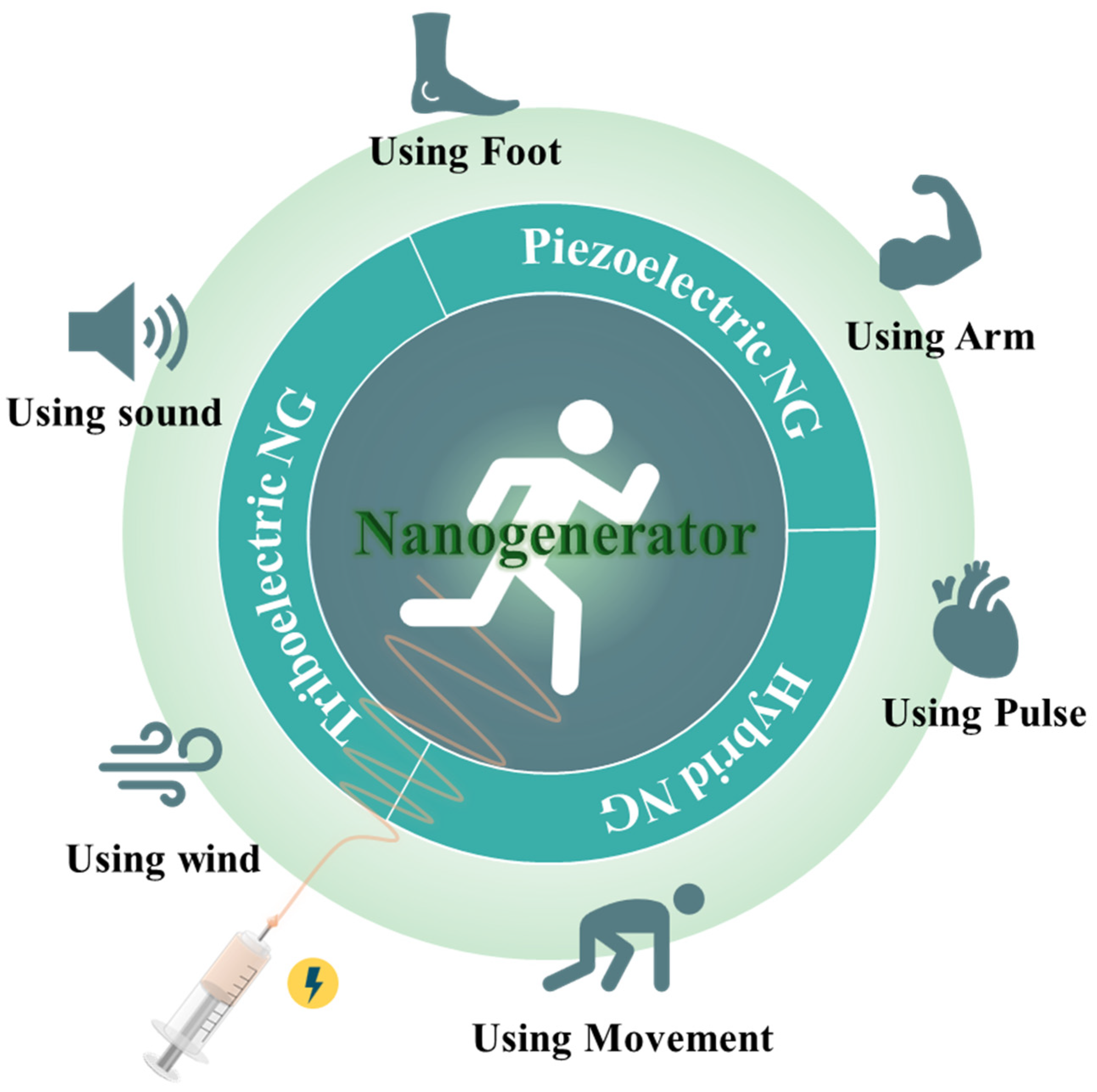



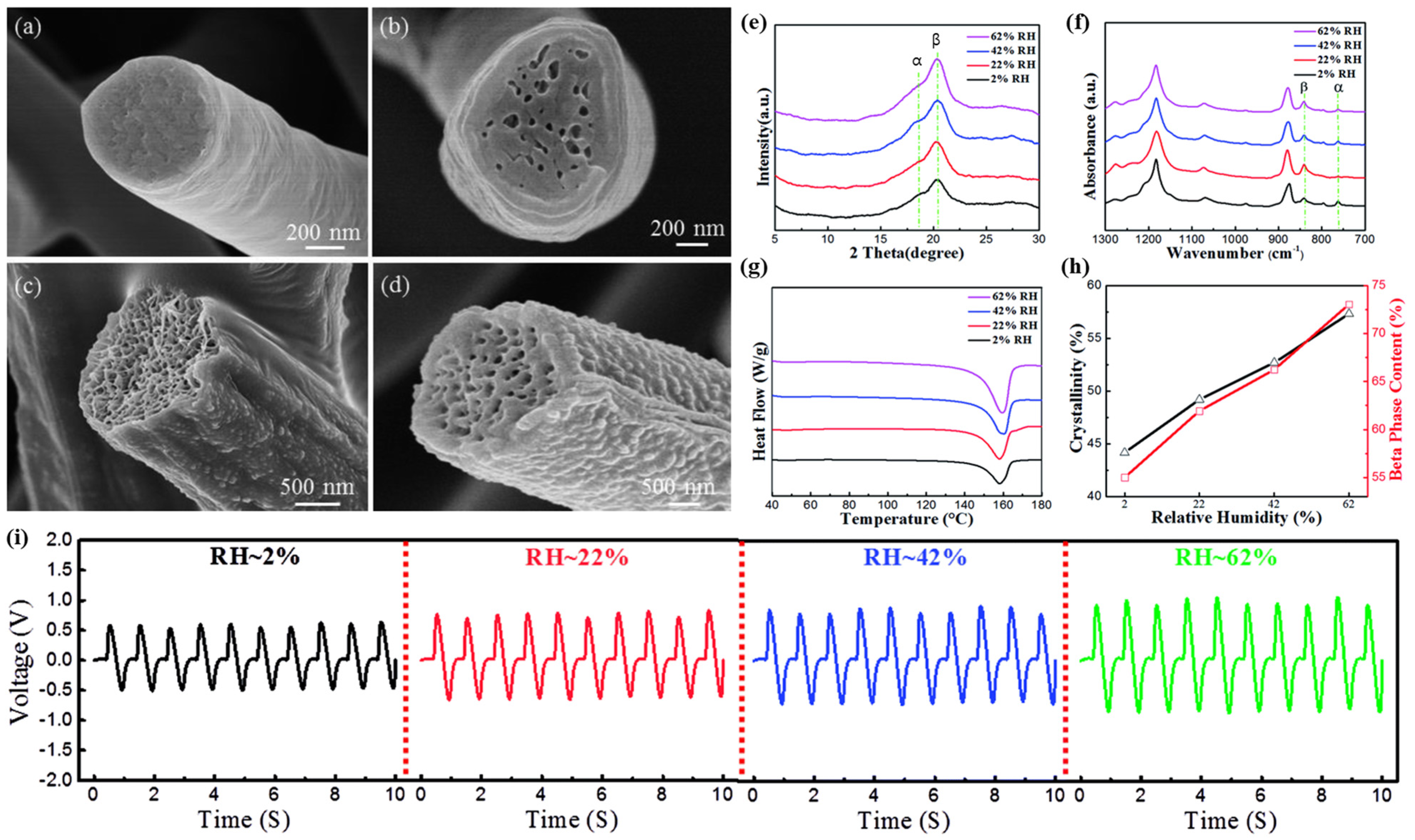
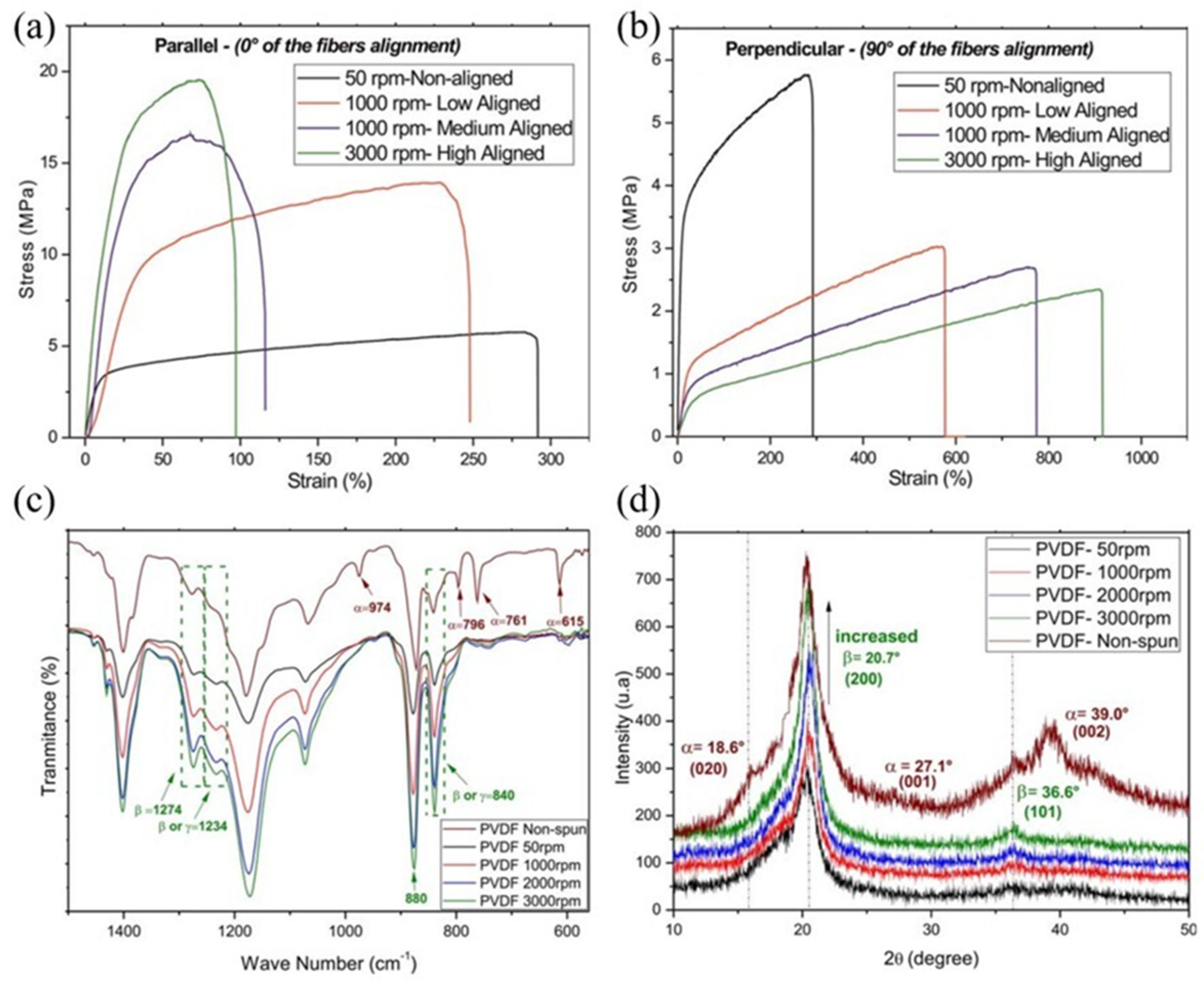

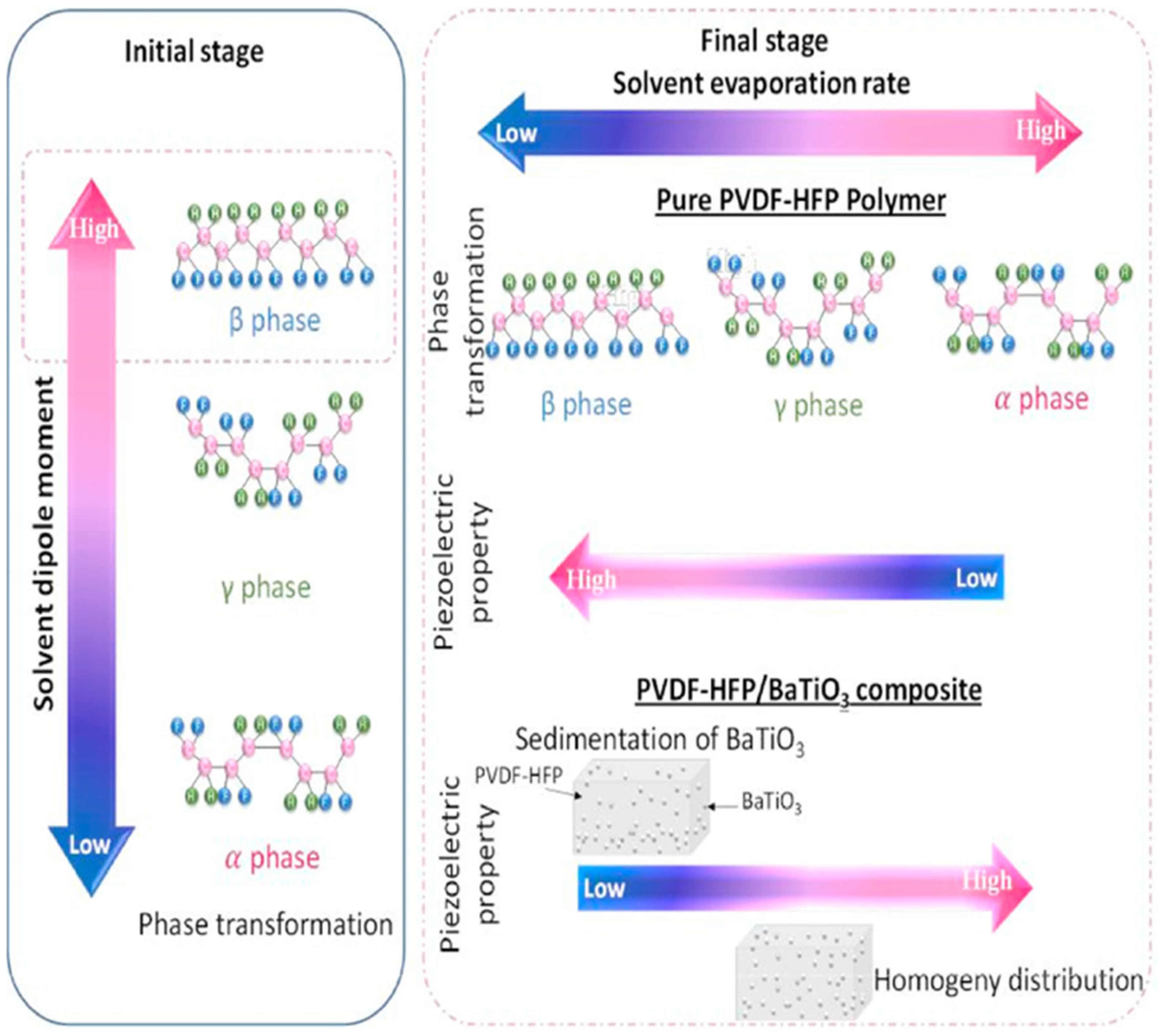



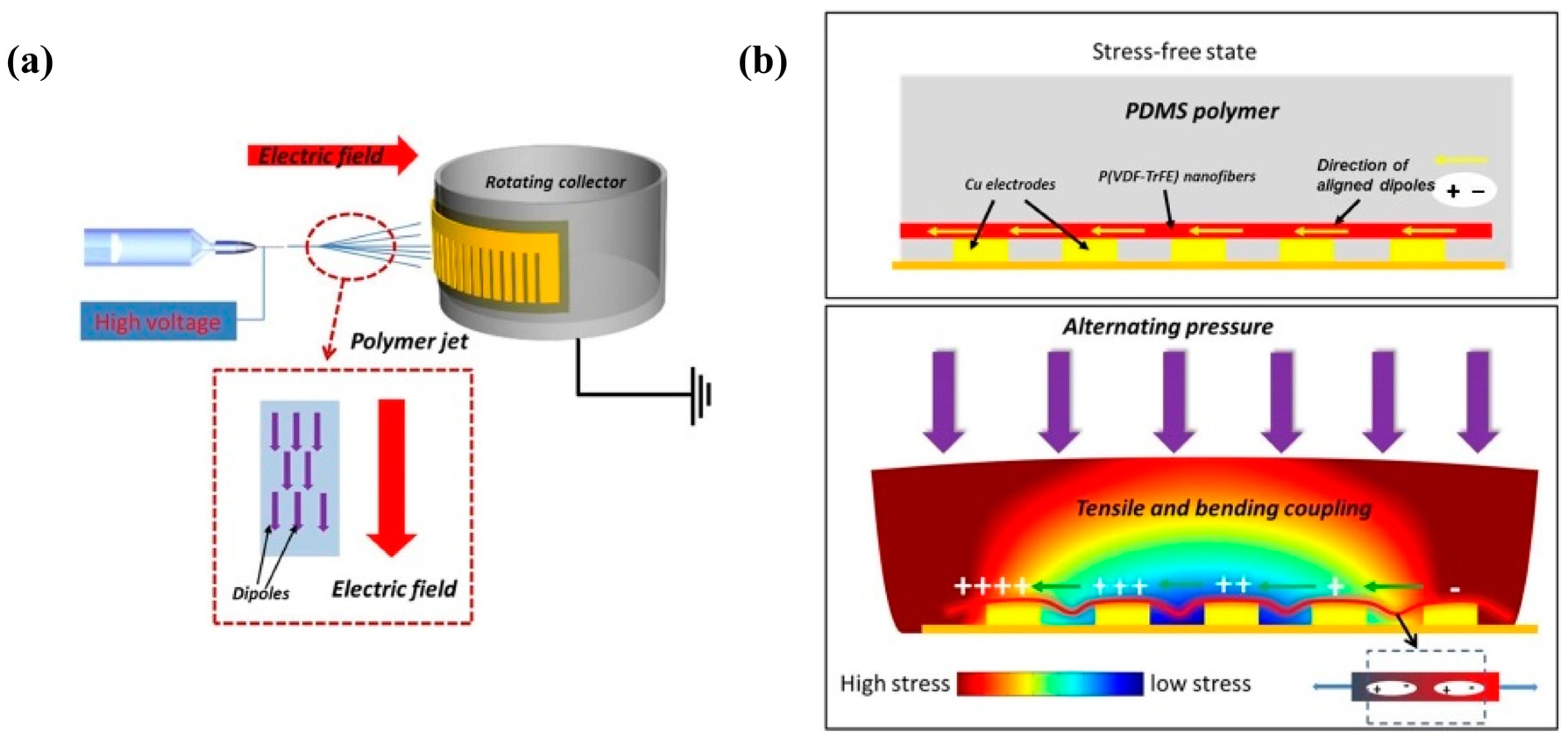
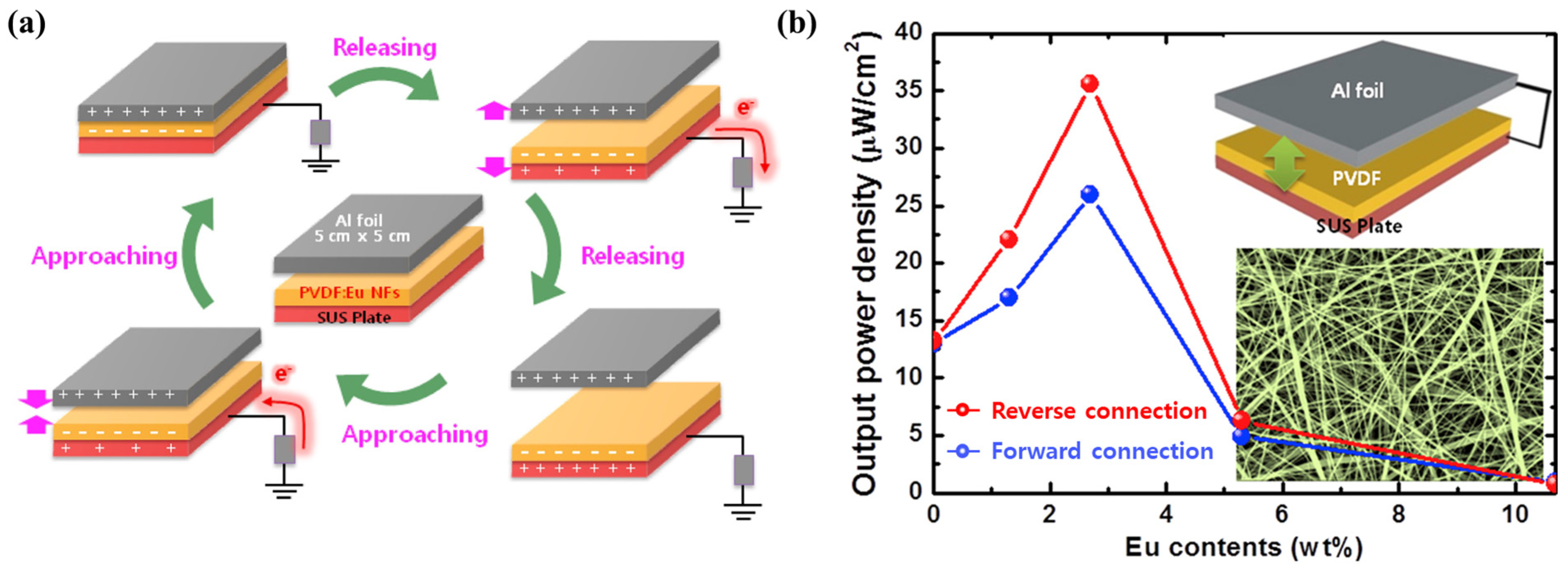
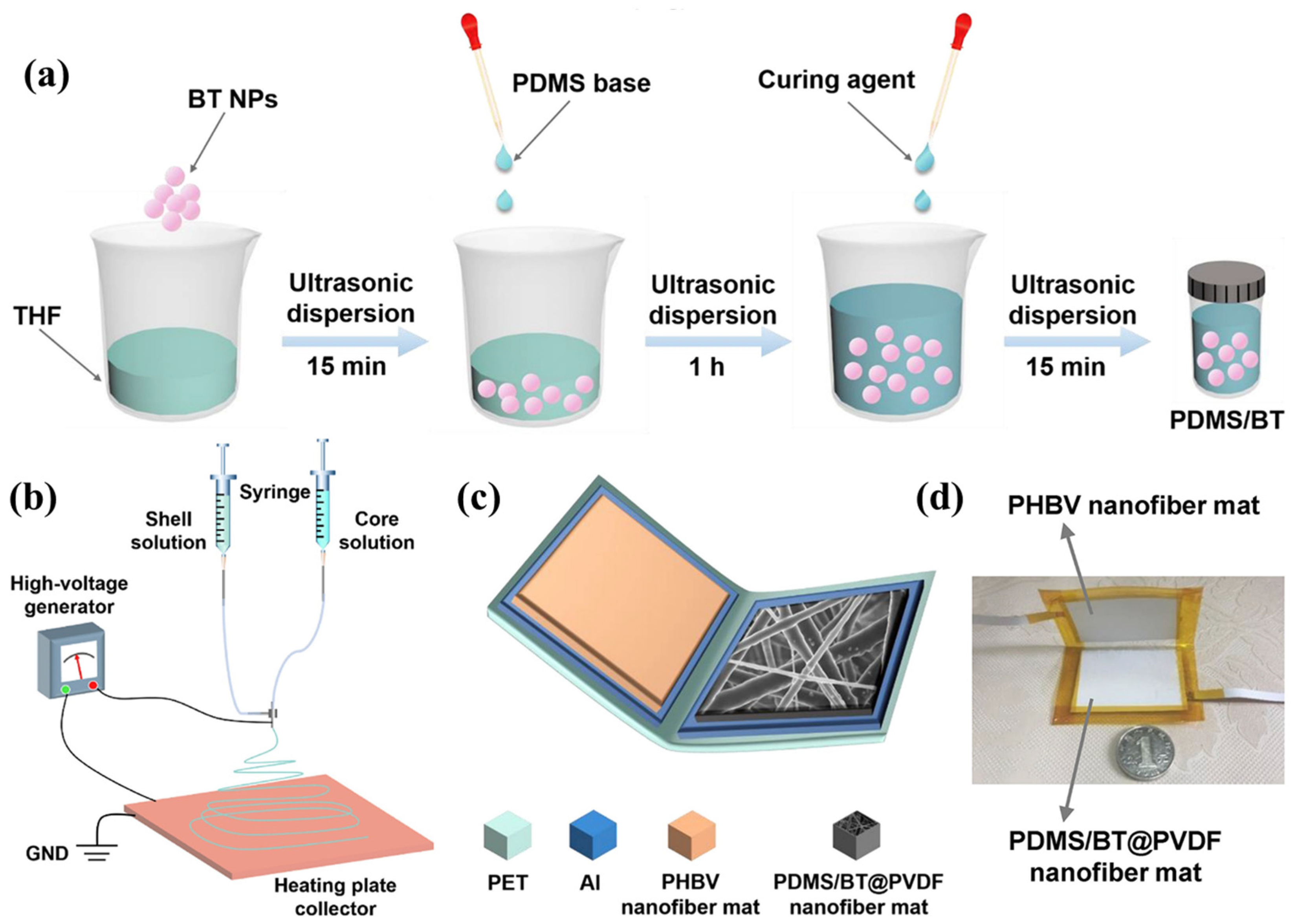
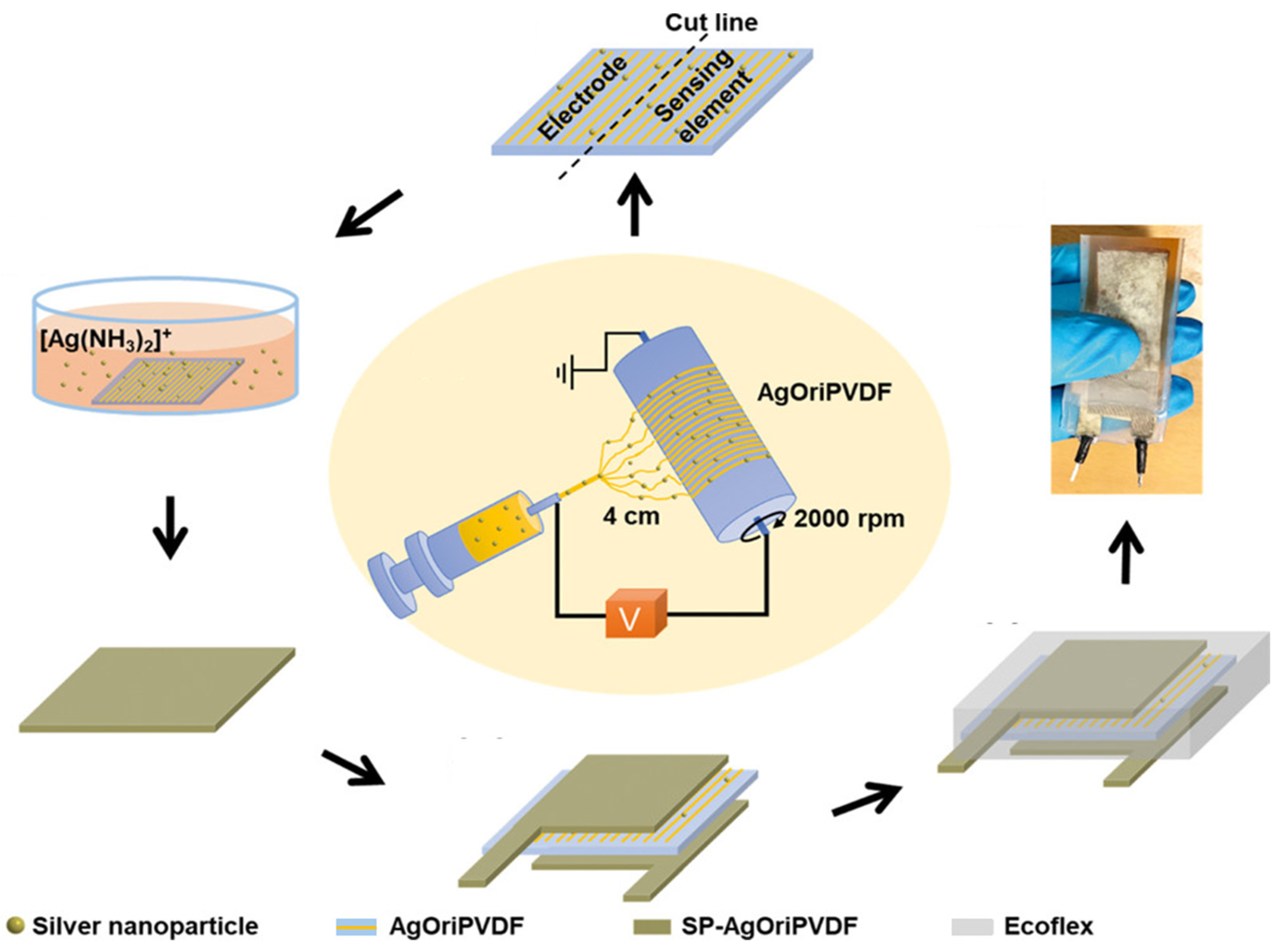
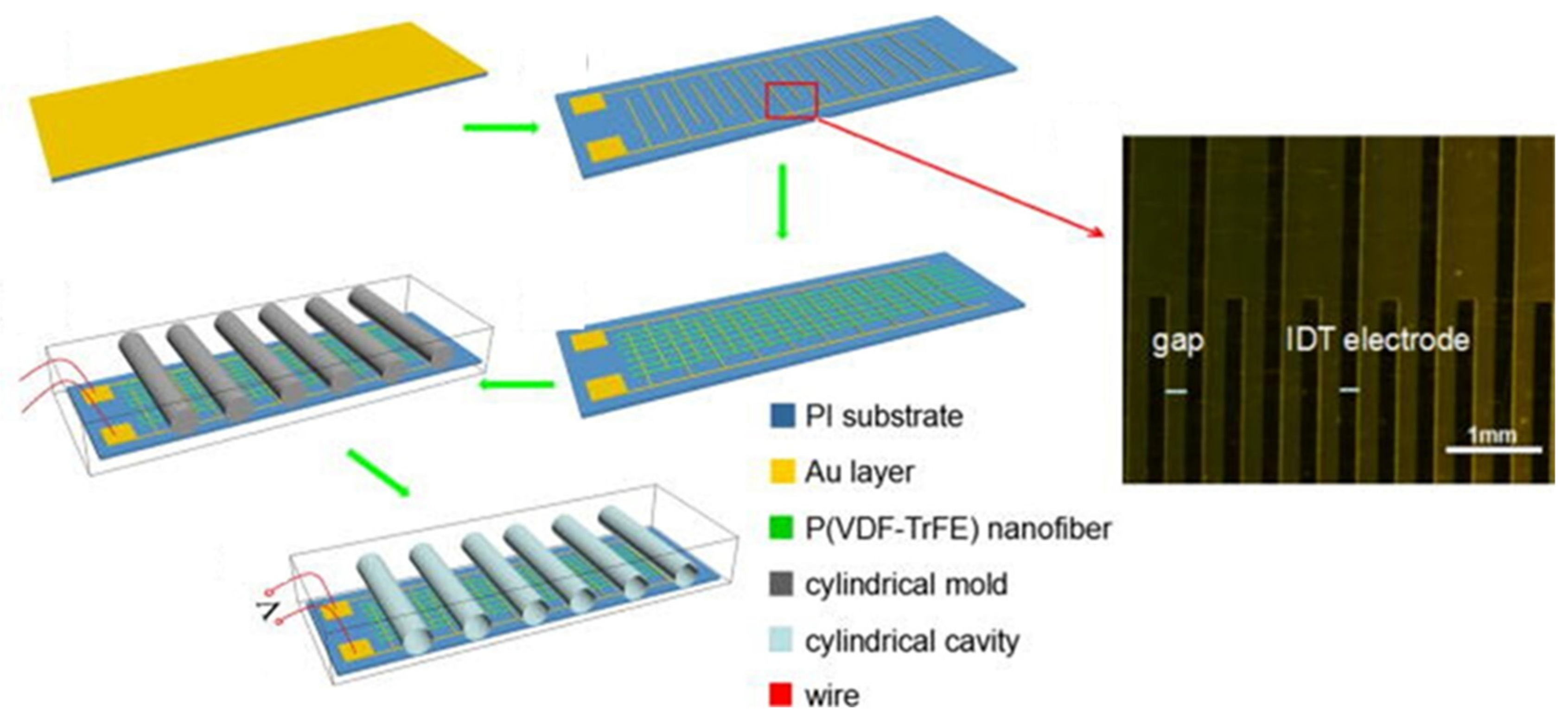
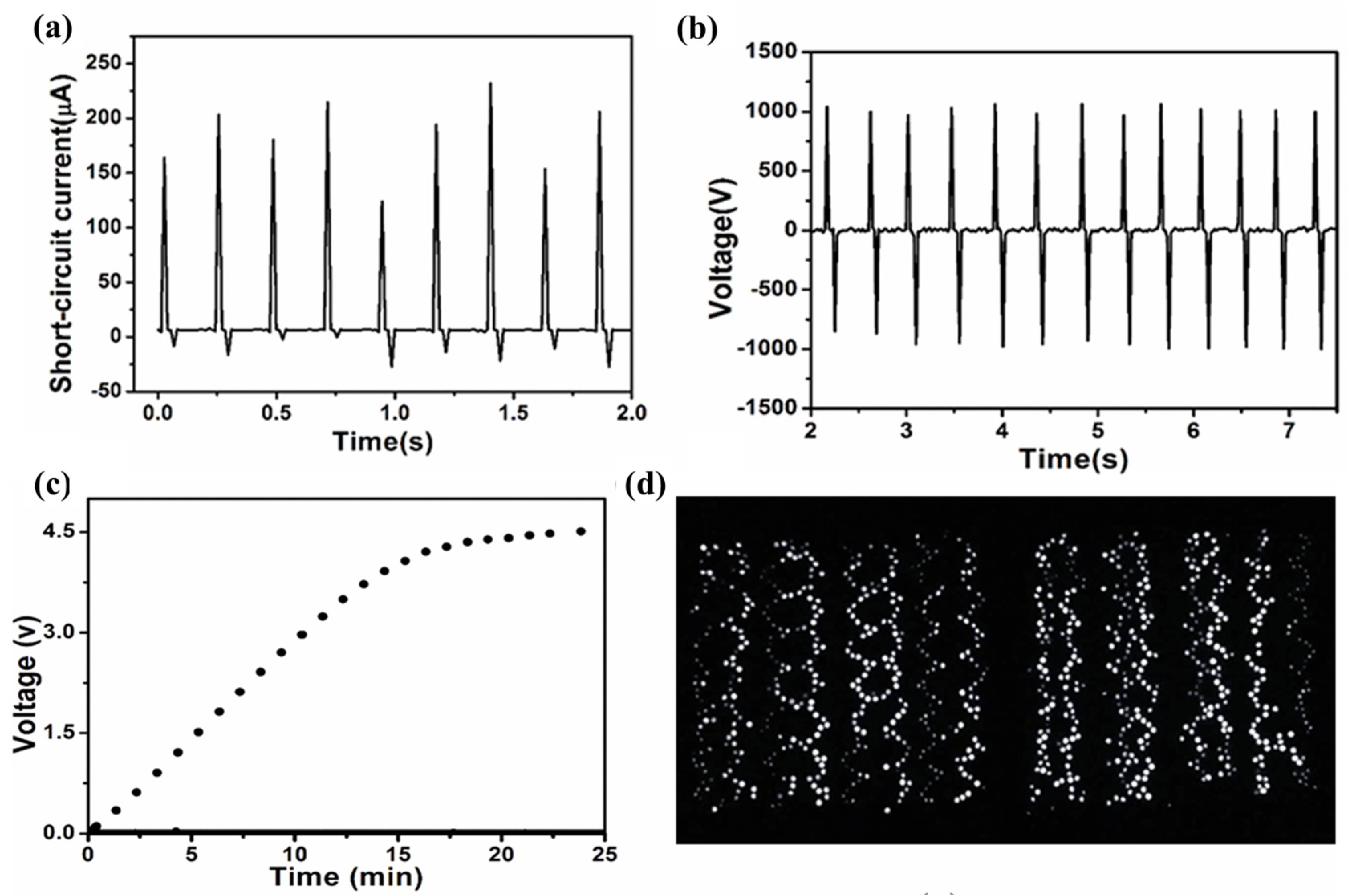

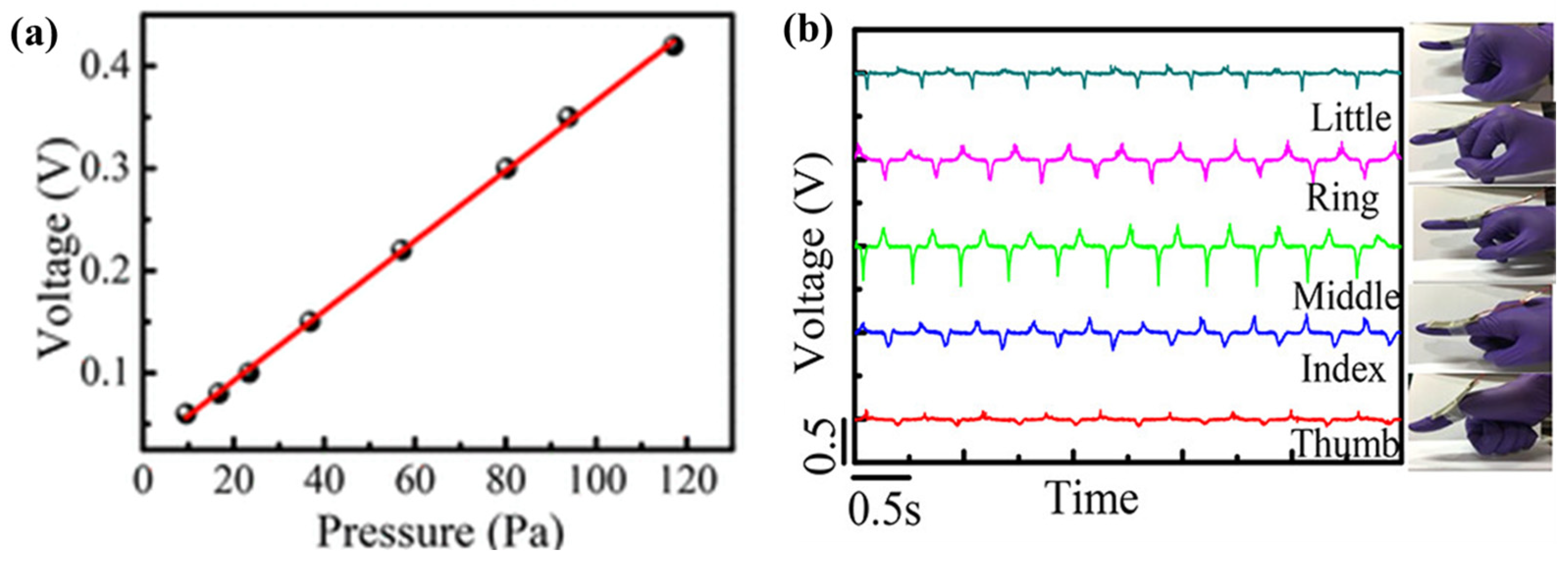
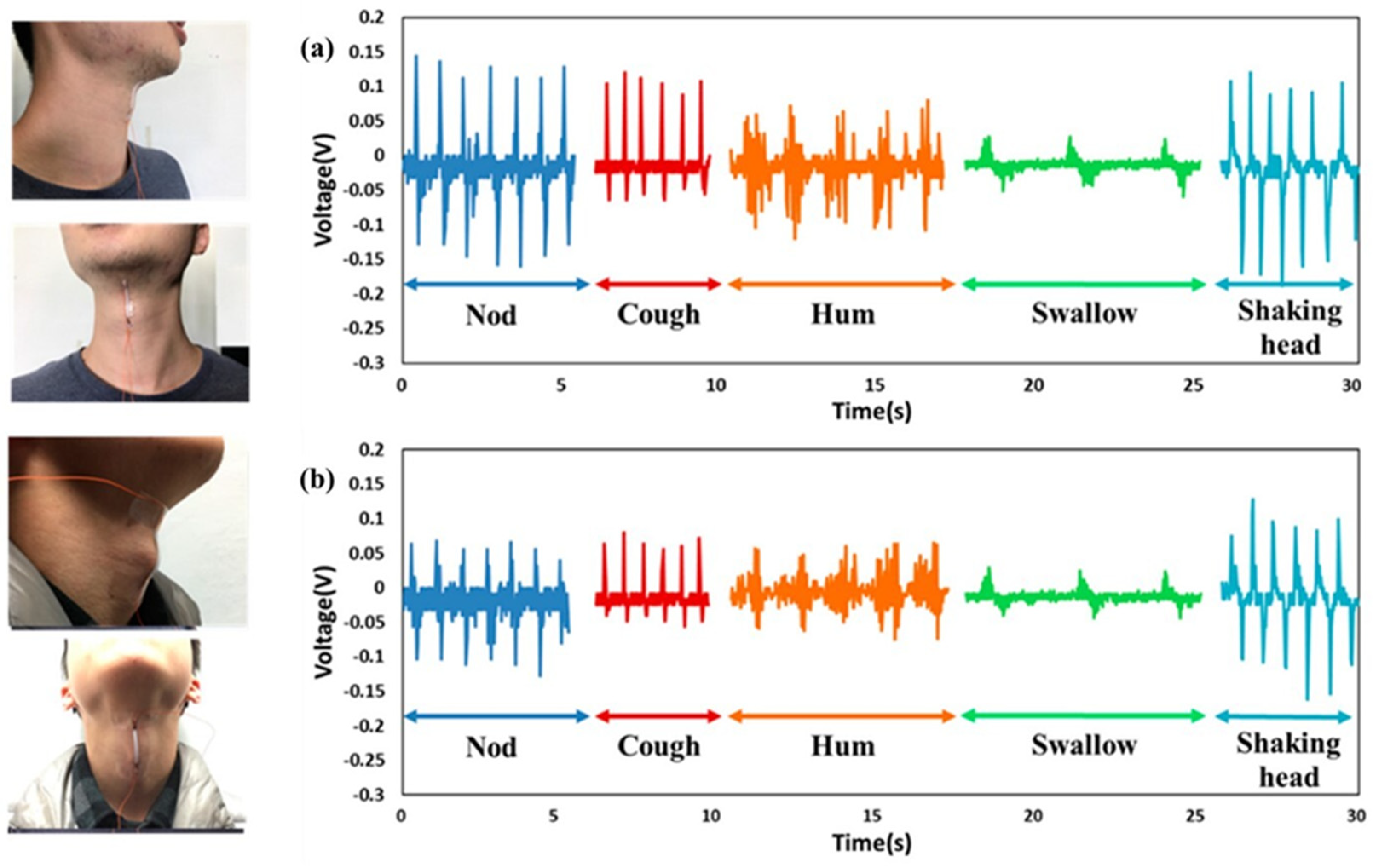
| Content (%) | Random Fibers | Aligned Fibers | ||||
|---|---|---|---|---|---|---|
| Wrinkled | Smooth | Porous | Wrinkled | Smooth | Porous | |
| F(β) | 87.53 | 83.04 | 79.72 | 87.57 | 83.67 | 81.99 |
| ∆Xc | 53.27 | 51.5 | 49.17 | 55 | 52.13 | 50.1 |
Disclaimer/Publisher’s Note: The statements, opinions and data contained in all publications are solely those of the individual author(s) and contributor(s) and not of MDPI and/or the editor(s). MDPI and/or the editor(s) disclaim responsibility for any injury to people or property resulting from any ideas, methods, instructions or products referred to in the content. |
© 2024 by the authors. Licensee MDPI, Basel, Switzerland. This article is an open access article distributed under the terms and conditions of the Creative Commons Attribution (CC BY) license (https://creativecommons.org/licenses/by/4.0/).
Share and Cite
Yoo, J.-U.; Kim, D.-H.; Choi, T.-M.; Jung, E.-S.; Lee, H.-R.; Lee, C.-Y.; Pyo, S.-G. Advancements in Flexible Nanogenerators: Polyvinylidene Fluoride-Based Nanofiber Utilizing Electrospinning. Molecules 2024, 29, 3576. https://doi.org/10.3390/molecules29153576
Yoo J-U, Kim D-H, Choi T-M, Jung E-S, Lee H-R, Lee C-Y, Pyo S-G. Advancements in Flexible Nanogenerators: Polyvinylidene Fluoride-Based Nanofiber Utilizing Electrospinning. Molecules. 2024; 29(15):3576. https://doi.org/10.3390/molecules29153576
Chicago/Turabian StyleYoo, Jin-Uk, Dong-Hyun Kim, Tae-Min Choi, Eun-Su Jung, Hwa-Rim Lee, Chae-Yeon Lee, and Sung-Gyu Pyo. 2024. "Advancements in Flexible Nanogenerators: Polyvinylidene Fluoride-Based Nanofiber Utilizing Electrospinning" Molecules 29, no. 15: 3576. https://doi.org/10.3390/molecules29153576





